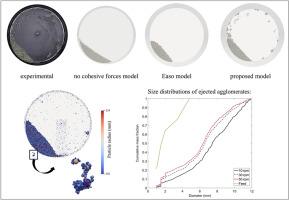Numerical analysis of particle agglomeration in a continuous pan granulator using DEM
IF 4.3
2区 材料科学
Q2 ENGINEERING, CHEMICAL
引用次数: 0
Abstract
Pan granulators are widely used in granulation processes; however, the relationship between particle dynamics within the equipment and the underlying agglomeration mechanisms remains not fully understood. To address this, the present study conducted numerical simulations using the Discrete Element Method (DEM) with cohesive contact force models. Various models were evaluated and compared with experimental data to determine the one that best represented the behavior of the granular bed. The selected model, which incorporates the Easo capillarity model for particle-particle interactions and the SJKR adhesion model for particle-wall interactions, yielded satisfactory results. The numerical findings highlighted significant changes in granular flow dynamics when cohesive forces were taken into account. Additionally, the influence of cohesive forces and rotational speeds on residence time distributions (RTD) was analyzed, revealing the presence of a short-circuit effect in all cohesive granular beds. Finally, a new methodology was developed to quantify particle agglomeration. Larger and more numerous agglomerates were observed when the pan granulator operated in rolling or cascading regimes, conditions that were associated with longer residence times and an increased number of particle contacts.

基于DEM的连续盘式造粒机颗粒团聚数值分析
盘式造粒机广泛应用于造粒过程;然而,颗粒动力学在设备和潜在的团聚机制之间的关系仍然没有完全了解。为了解决这一问题,本研究使用具有粘性接触力模型的离散元法(DEM)进行了数值模拟。对各种模型进行了评估,并与实验数据进行了比较,以确定最能代表颗粒床行为的模型。所选择的模型结合了Easo颗粒-颗粒相互作用的毛细模型和SJKR颗粒-壁相互作用的粘附模型,得到了令人满意的结果。数值结果突出了当考虑内聚力时颗粒流动动力学的显著变化。此外,还分析了黏结力和转速对停留时间分布(RTD)的影响,揭示了在所有黏结性颗粒床中都存在短路效应。最后,提出了一种量化颗粒团聚的新方法。当盘式造粒机在滚动或级联状态下运行时,观察到更大、更多的团块,这些条件与更长的停留时间和增加的颗粒接触次数有关。
本文章由计算机程序翻译,如有差异,请以英文原文为准。
求助全文
约1分钟内获得全文
求助全文
来源期刊

Particuology
工程技术-材料科学:综合
CiteScore
6.70
自引率
2.90%
发文量
1730
审稿时长
32 days
期刊介绍:
The word ‘particuology’ was coined to parallel the discipline for the science and technology of particles.
Particuology is an interdisciplinary journal that publishes frontier research articles and critical reviews on the discovery, formulation and engineering of particulate materials, processes and systems. It especially welcomes contributions utilising advanced theoretical, modelling and measurement methods to enable the discovery and creation of new particulate materials, and the manufacturing of functional particulate-based products, such as sensors.
Papers are handled by Thematic Editors who oversee contributions from specific subject fields. These fields are classified into: Particle Synthesis and Modification; Particle Characterization and Measurement; Granular Systems and Bulk Solids Technology; Fluidization and Particle-Fluid Systems; Aerosols; and Applications of Particle Technology.
Key topics concerning the creation and processing of particulates include:
-Modelling and simulation of particle formation, collective behaviour of particles and systems for particle production over a broad spectrum of length scales
-Mining of experimental data for particle synthesis and surface properties to facilitate the creation of new materials and processes
-Particle design and preparation including controlled response and sensing functionalities in formation, delivery systems and biological systems, etc.
-Experimental and computational methods for visualization and analysis of particulate system.
These topics are broadly relevant to the production of materials, pharmaceuticals and food, and to the conversion of energy resources to fuels and protection of the environment.
 求助内容:
求助内容: 应助结果提醒方式:
应助结果提醒方式:


